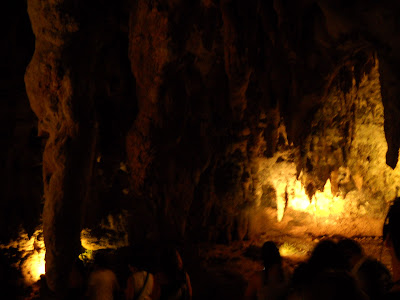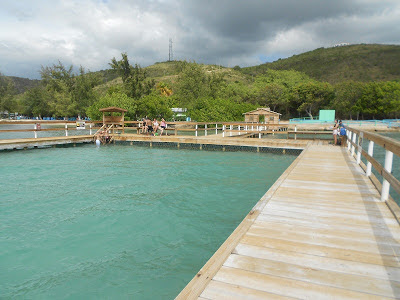Tourists for a Day
Saturday morning, Rachel, Danielle, and I got up and left Guayama before 9am (practically on schedule!!) and headed across the island to Camuy and the Rio Camuy Caves.
The day was overcast, but not rainy—a perfect day, we commented, to spend inside a cave. The 2 hour drive was uneventful and pleasant. We didn’t even get lost.
As we neared the caves, we passed more and more stands offering pinchos, hamburgers, barbeque, pina coladas and coco frio, or other Puerto Rican treats. Our stomachs growled. As we passed a large pincho stand with smoke spiraling to the sky from the grill, we all commented about how good it looked. “Should I stop?” I asked. “I dunno…guess you could…” came a noncommittal reply. I pulled over into the gas station parking lot right beyond the stand. This decision was a great one. We discovered that they were selling not just any pinchos, but Super Pinchos. They were, quite possibly, the best pinchos I have had so far in PR. They were HUGE, all chicken and almost no fat, AND you get to choose between sweet or spicy sauce! And the bread… Pinchos are generally served with French bread. Usually it’s squished and cool. The bread that came with our Super Pinchos was toasted with garlic, fresh and delicious.
Enough gushing about our chicken on a stick? I guess so.
We arrived at the caves around 11:15am. We’d heard that the caves often fill up and you can find yourself with a long wait for a tour. So we were excited to find a nearly empty parking lot on Saturday! We had to wait no more than 20 minutes for our tour to begin.
We boarded a trolley and were taken down a steep hill, through rain forest type vegetation, to the mouth of a cave. There, we got out and walked into the entrance, playing our audio tours to hear all of the details about what we were seeing. (The audio tour was nice because it meant the guide didn’t have to shout and also didn’t have to translate everything between Spanish and English, but it was also not as great as a live tour because the information was more general.)
 |
| The trolley ride down to the cave mouth |
 |
| Mouth of the cave-- tree growing upside down!! |
The cave was definitely impressive. The entrance opens up to a huge cavern—la Cueva Clara (so named because the light from outside reaches inside) with stunning stalactites and stalagmites abounding. We snaked through the cavern, poked out heads into the sink hole and looked down at the Rio Camuy, drank from the “fountain of youth,” then came back inside and entered the “labyrinth.” The tour was too short, in my opinion (I would have liked to explore deeper in the cave—there are close to 15 miles of cave system, if I remember right), but what we did see was impressive enough to make the trip worth it.
 |
| Entering la Cueva Clara |
 |
| Opening into the sinkhole |
 |
| Looking up into the sinkhole |
After the cave, we headed to the Areceibo Observatory, which is close by. We only got a LITTLE lost on the way (and Danielle and Rachel had to get out at one point, cross the street, and move a tree from in front of a sign pointing the correct direction to the observatory), but we found it.
The Areceibo Observatory houses the largest radio telescope in the world. It’s also where the movie Contact (which I don’t think I’ve seen) was filmed.
We parked in the lot, then climbed a huge hill up to the visitor center and telescope. Inside the visitor center, there are many interactive displays with science information. All were interesting, but involved too much reading for us to focus. The really interesting part to me was the short presentation about the telescope and observatory, and the tour of the telescope itself. I wish I could have a copy of their presentation, because the information blew me away.
Here’s some of what I remember:
There are 3 reasons for the observatory being built where it is. First of all, it was built by someone from the US and therefore needed to be in a US territory. It also needed to be as close to the equator as possible, because this area is the best for viewing the part of the atmosphere/solar system that they wanted to study. Therefore, Puerto Rico was the best choice. And also, there just so happened to be a sink hole of the perfect size in Areceibo; so they didn’t have to dig a 305 meter hole to build the basin. It was just there.
The panels are made of aluminum, so they never rust. They are also perforated (and there’s a hole in the center of the basin) so that rain water does not collect. There is a black mold that does grow on them. Once, the center shut down for an entire month in order to clean the panels. They tested their sensitivity before and after the cleaning—and it didn’t change. So removing the mold is just for looks.
The telescope is supported by 3 towers; 2 are 265ft tall, and one is 365ft tall.
The huge Gregorian dome (where the reflectors are) moves so they can angle the telescope and get just the information that they want. We actually saw it move; it was so cool!! The dome weighs about 1000 tons (or something close to that, I think).
We headed for home a little after 4:00, happy with our day, visions of pizza dancing in our heads.
What happened next? Check out my post on Spare Tires.











Comments
Post a Comment